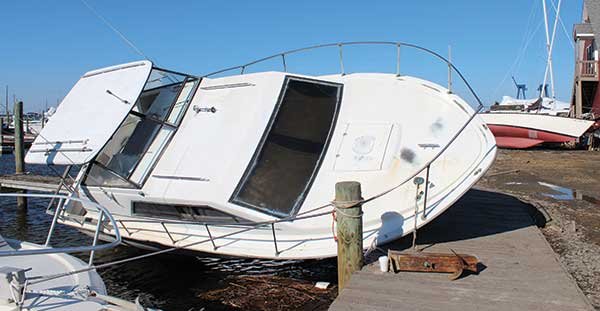
PREPARE FOR THE STORM BEFORE IT HITS
As the Dominican Republic gets slammed with Hurricane Fiona, you should be checking your plans. That means having a well-thought-out plan long before a hurricane warning is posted. To be successful, your hurricane plan needs to address the where, when, who, and what of hurricane preparation.
Where Will You Store The Boat?
As with real estate, three things matter most: location, location, location. Your boat's chances of surviving a hurricane undamaged are highest if it's where the worst of the storm isn't. When it's practical and safe, moving your boat out of the way is the best strategy. If your boat is trailer-able take it inland and to high ground; if not, you or a captain can relocate it by water. When hurricanes threaten the Northeast, hundreds of coastal and offshore boats migrate north to Maine or up the Connecticut and Hudson rivers.
But if your boat is farther south, the lack of precision in forecasting makes relocating the boat by water a risky proposition. You may end up moving it into the storm's path or, worse, finding yourself offshore in the middle of a hurricane. If getting the boat out of the way of the storm isn't safe or practical, our files show that boats on the hard land, suffer relatively less damage than those in the water. When the boat is left at a mooring, at anchor, or tied to a dock and something goes wrong, it's more likely to end up sinking or aground than if it had been ashore. That can be extremely costly. In addition to losing your boat, there could be expenses for cleaning up any spilled fuel and removing the wreckage that results. Unless your marina docks have been engineered and built to withstand hurricane-force winds and the accompanying surge, WE recommend hauling the boat and securing it on the hard.
Whether you haul the boat or leave it in the water, your most obvious option is to leave it wherever it is. But the place where you normally keep your boat may be a disastrous one in a hurricane. Here are the key factors to consider when assessing how well a particular location might protect your boat in a tropical storm.
Surge
Most people think wind poses the greatest threat to life and property from a hurricane. In fact, storm surge poses at least as much danger. Superstorm Sandy's wind speeds were below hurricane force when it made landfall in New Jersey, but its surge damaged or destroyed an estimated 65,000 recreational boats. In Hurricane Katrina in 2005, some 1,500 people lost their lives, and many of those deaths occurred directly or indirectly as a result of storm surge. The National Oceanographic and Atmospheric Administration (NOAA) has created an experimental website where you can zoom in on your locale to see what the maximum surge height above ground level would be in a direct hit by a Category 1 through Category 5 hurricane. You can use that data to assess whether the piling heights on floating docks are high enough to keep the finger piers from being lifted off the pilings and to gauge how high storm surge could be in the hard-stand area. While you're at it, if you live in a coastal area, you might want to see how your house would fare. Google "ArcGIS Storm Surge" to find the website.
Fetch
When wind blows across open water, it generates waves. Breaking waves have a tremendous amount of power; they regularly destroy massive concrete structures at the water's edge. The height of the waves depends upon wind strength, duration, water depth, and the exposed distance (called the fetch). Hurricane-force winds blowing across half a mile (the fetch) of open water 25 feet deep can generate waves of 2.5 feet and more in height. Increase that distance to 10 miles, and waves will grow to a minimum of 6 feet high. Wind direction is determined by which part of the hurricane passes over your location, so when putting together your hurricane plan, assume that you could get wind from any direction. If your marina is exposed to open water, or protected from open water only by a breakwall, it's vulnerable to wave damage, especially if there's also a surge risk. In Sandy, the combination of surge and waves lifted boats stored on the hard off their jackstands and carried them inland, sometimes for miles.
Flooding
Hurricanes can bring rains of 6 to 12 inches in 24 hours, which can overwhelm the cockpit drainage of boats in the water, causing them to sink; the rainfall can also find its way through any fitting or hatch that isn't completely watertight, flooding the boat. If your marina is located in a low-lying area or near a river, floodwaters can combine with surge to further increase the maximum water height above ground level. Take that into account when considering piling heights or the height of the hard stand above sea level.